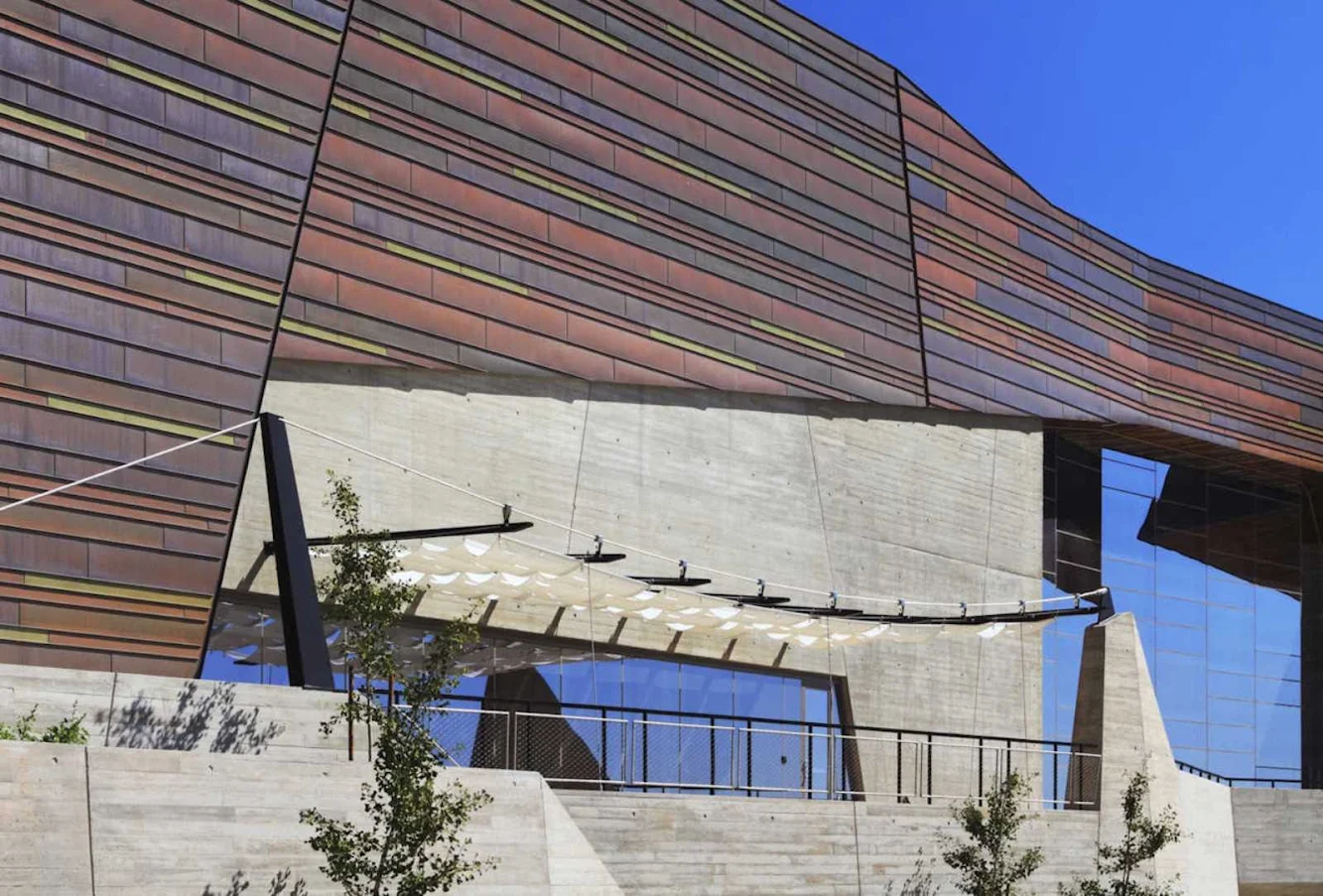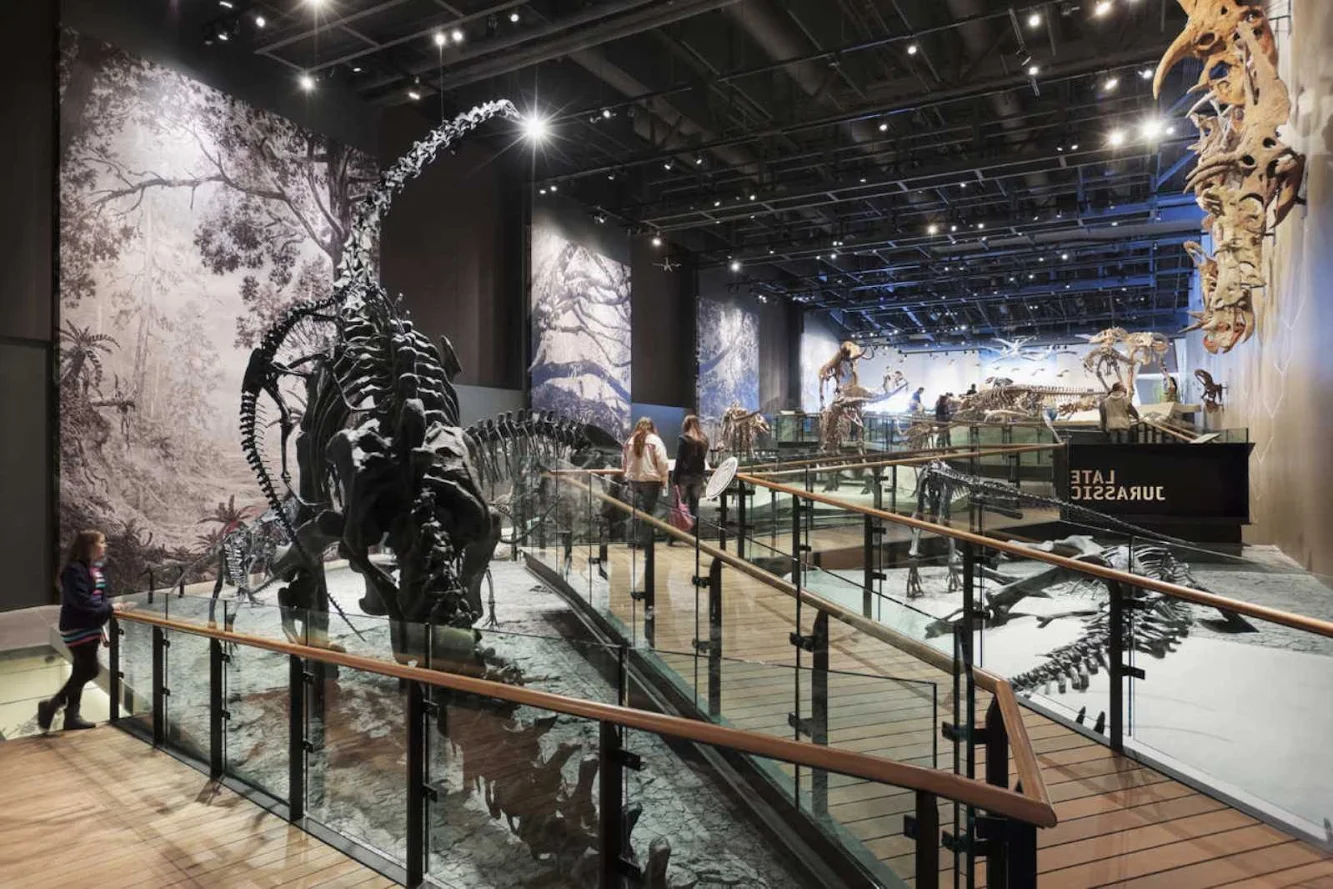
Inspired by the State’s singular landscape, Todd Schliemann has designed a commanding building, whose powerful profile and copper skin blend seamlessly into the foothills of the Wasatch Mountain Range.The terraced structure is anchored into its sloping site at the edge of the University of Utah campus, a few miles from downtown, while the folded and subtly canted exterior walls mimic the scrubby hillside rising behind it.

The designers have integrated this infrastructure with the site by realigning and redefining the trailhead with gabion walls whose rock was uncovered during foundation excavation, and by camouflaging the utilities with sculptural landforms. They configured the new building as a three-bar form that steps up with the terrain.

Its structure, which combines concrete shear walls and steel framing, is organized into two wings—one that supports the museum's “empirical” activities, including research, conservation, and administration; and an “interpretive” wing that houses the exhibits, says Schliemann.

The glue between the two programmatic halves, and the museum's centerpiece, is a 60-foot-tall lobby that doubles as a space for lectures and parties. It is enclosed by soft, gray board-formed concrete, warm, white-faceted drywall planes, and one glazed wall that offers sweeping views out over the city and across Salt Lake Valley.

The simile of architecture-as-geological-formation extends to the building's exterior envelope, where horizontal standing-seam copper—mined on the opposite side of the valley and donated by the mine's parent company—covers the angular walls above the a poured-in-place concrete base. the cladding, made of three different alloys, takes on a varied patina, creating an effect similar to the striations of exposed rock cliffs.

Although this skin is now different shades of brown with hints of green, its colors will continue to evolve, much like the landscape around the building where Gambel oaks, two types of maples, native sumac, and an understory of several varieties of brush, have been planted. in the autumn the foliage will turn nutty brown, vibrant orange, and red. the route through the exhibits, which were designed by New York-based Ralph Appelbaum Associates, also takes its cues from the natural environment.

Ramped walkways with ipé-plank decks and glass balustrades trace a gently ascending course that winds through the museum's 10 thematic galleries in the manner of a mountain traverse. the path leads from the lowest level displays, which showcase the region's plant and animal life over 225 million years, to the uppermost exhibition space, which focuses on the traditions of Utah's native peoples. Along the way, visitors can examine artifacts from the museum's collection of 1.2 million objects, including paleontological, archaeological, and mineralogical specimens.

But museumgoers need not view the galleries in any particular order or follow a prescribed course, according to Sarah George, executive director. Instead, they can get off the elevator on any level, cross one of the bridges spanning the canyon, and explore just one section of the museum. “It was important to us that visitors be able to chose their own path,” she says. the galleries are primarily inwardly focused, with few windows in order to protect the collections from damaging ultraviolet light.

However, in a select number of carefully orchestrated locations, windows are included so that museumgoers can make connections between the displays and the world outside. For example, an exhibit exploring the evolution of the Great Salt Lake is positioned next to a window that offers views of the actual body of water off in the distance.

The small number of windows—and the resulting low-window-to-wall ratio—helps improve the building's energy performance and is one of several strategies that have put the project on track for Leed Gold certification. (For more on the envelope, see Performance Puzzle) But because site constraints dictated that most of the openings face west—an undesirable orientation from both heat-gain and conservation perspectives—the high-performance glazing includes a frit and a low-e coating.












Location: Salt Lake City, Utah, Usa Architect: Ennead Architects Architect of Record: Gsbs Architects Design Partner: Todd Schliemann Faia Management Partner: Don Weinreich Aia, Leed Ap Project Designers: Thomas Wong Aia, Alex O’Briant Aia Project Architects: John Majewski Aia, Megan Miller Aia, Leed Ap Interiors: Charmian Place, Katharine Huber Aia Project Team: Joshua Frankel Aia, Aileen Iverson, Kyo-Young Jin, Apichat Leungchaikul, Thomas Newman, Jarrett Pelletier Aia Construction Manager: Big-D Construction Year: 2011 Photographs: Jeff Goldberg/Esto, Stuart Ruckman, Ben Lowry